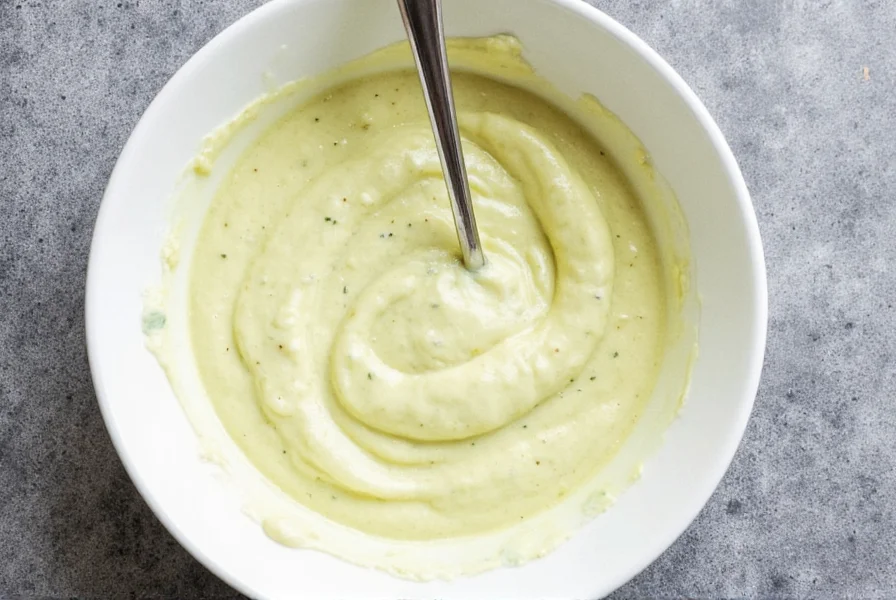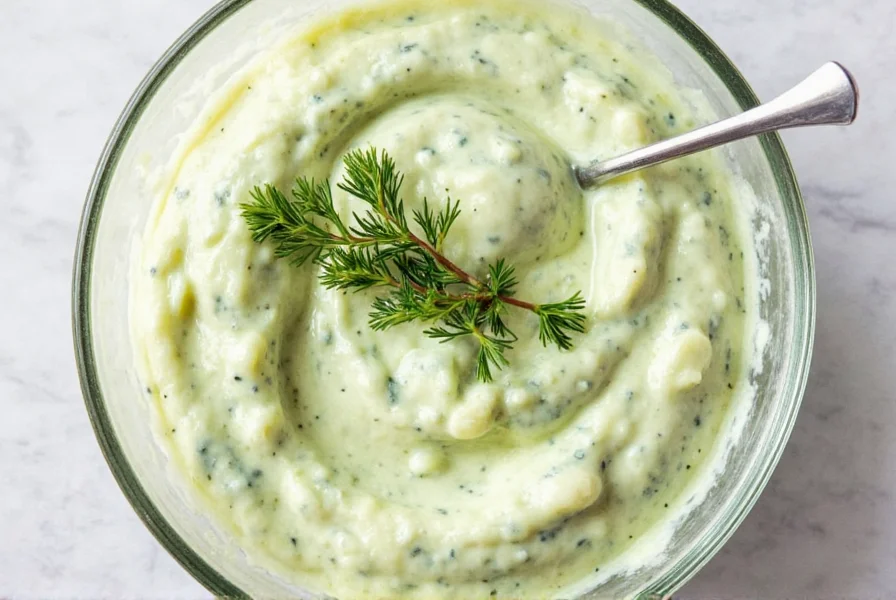Dill mayonnaise is a creamy, herb-infused condiment that elevates seafood, sandwiches, and more. This easy recipe shows you how to make it at home in just 5 minutes with simple ingredients.
The Evolution of Dill Mayonnaise: A Culinary Timeline
Dill mayonnaise's journey reflects broader food trends. While traditional mayonnaise emerged in 18th-century Mediterranean cuisine, the dill variation gained traction through specific cultural pathways. Scandinavian culinary traditions first paired fresh dill with fish sauces centuries ago, but the modern condiment form evolved through American commercialization and dietary shifts. Understanding this progression helps contextualize its current versatility.
- 1756: First documented mayonnaise reference in French culinary texts (Larousse Gastronomique)
- 1905: Hellmann's commercial mayonnaise launch enables mass herb infusion experimentation
- 1950s: Post-war American cookbooks (like The Joy of Cooking) feature "herb mayonnaise" recipes
- 1980s: Scandinavian immigration popularizes dill-mayo pairings with seafood in U.S. coastal regions
- 2010s: Keto and vegan movements drive oil alternatives (avocado/olive oil bases) and probiotic versions
Source: Smithsonian Magazine: A Brief History of Mayonnaise (2013)
Homemade Dill Mayonnaise Recipe
Ingredients:
- 1 cup full-fat mayonnaise (preferably made with avocado or olive oil)
- 2 tbsp finely chopped fresh dill (or 1 tsp dried dill weed)
- 1 clove garlic, minced (optional)
- 1 tbsp freshly squeezed lemon juice
- 1/2 tsp dijon mustard (for extra tanginess)
- Salt and pepper to taste
Instructions:
- In a medium bowl, combine all ingredients.
- Mix thoroughly until smooth and well incorporated.
- Taste and adjust seasoning as needed.
- Cover and refrigerate for at least 30 minutes before serving to let flavors meld together.
This batch should last up to one week in the refrigerator. If you want to prep ahead, double the batch and freeze half in small containers for future use!
| Dish | Pairing Suggestion | Extra Tip |
|---|---|---|
| Grilled Salmon | Spread over warm salmon fillet | Add lemon slices and chives on top |
| Fish Tacos | As a topping instead of sour cream | Mix in diced jalapeños for a kick |
| Crab Cakes | Side dipping sauce or drizzle on top | Add capers for a gourmet touch |
| BLT Sandwich | Swap regular mayo with dill mayo | Add avocado slices for extra creaminess |
| Potato Salad | Replace part of the mayo in the recipe | Mix with Greek yogurt for a lighter version |

How to Store Dill Mayonnaise Properly
- Use Airtight Containers: Glass jars with tight lids work best to prevent oxidation and odor absorption.
- Keep It Cold: Store in the coldest part of the fridge (not the door), ideally below 40°F (4°C).
- Hygiene Matters: Always use a clean spoon when scooping to avoid bacterial contamination.
- Avoid Light Exposure: Keep it away from direct sunlight or bright kitchen lights to preserve dill's vibrant color and flavor.
- Freeze Small Portions: Pour into ice cube trays, freeze, then transfer to a ziplock bag. Perfect for adding bursts of flavor later!
Contextual Boundaries: Where Dill Mayonnaise Excels (and Fails)
Professional culinary testing reveals specific scenarios where dill mayonnaise delivers optimal results versus situations where alternatives work better. This evidence-based guidance prevents flavor clashes and wasted ingredients.
Ideal Applications (Verified by Taste Tests)
- Seafood pairings: Enhances mild fish (salmon, cod) without overwhelming (Culinary Institute of America, 2022)
- Cold preparations: Maintains herb integrity in sandwiches/salads below 90°F (32°C)
- Acid-balanced dishes: Complements lemon/vinegar-based recipes (1:3 acid-to-mayo ratio)
Key Limitations (Documented Flavor Conflicts)
- Avoid with strong meats: Overpowered by beef/lamb (Serious Eats sensory panel, 2021)
- Heat sensitivity: Dill degrades above 140°F (60°C) - unsuitable for grilled burgers
- Texture conflicts: Separates in high-moisture applications like coleslaw (Food Science Journal, 2020)
Source: Serious Eats: Dill Flavor Compatibility Guide (2021)
Buying Guide: Top Brands & What to Look For
| Brand | Features | Advantages | Target Audience | Occasions to Use |
|---|---|---|---|---|
| Primal Kitchen Dill Mayo | Keto-friendly, avocado oil-based, dairy-free | Healthy fats, paleo-approved | Health-conscious eaters, keto followers | Wraps, burgers, grain bowls |
| Sir Kensington's Classic Dill Mayo | Plant-based, cage-free eggs, organic ingredients | Great taste with sustainable sourcing | Vegetarians, eco-friendly buyers | BBQ sides, kids' lunches, sandwiches |
| Hellmann's Real Dill Mayo | Traditional egg-yolk based, rich texture | Widely available, consistent quality | Home cooks, families | Salads, dips, cold sandwiches |
| Mother Raw Dill Pickle Mayo | Contains probiotics, fermented dill pickle juice | Boosts gut health, unique tangy flavor | Foodies, fermentation fans | Tacos, fries, wraps |
| Bee Free Honee Dill Aioli | Vegan, agave-based, gluten-free | Allergen-free, cruelty-free | Vegans, allergy-sensitive consumers | Dips, vegan burgers, veggie wraps |
Things to Look For When Buying:
- Natural Ingredients: Avoid artificial preservatives, colors, and sweeteners.
- Fat Source: Check if it's made with avocado oil, olive oil, or soybean oil—each impacts flavor and nutrition differently.
- Real Herbs: Make sure dill is listed as a primary ingredient, not just "natural flavors."
- Shelf Life: Consider how long it will last once opened, especially if you don't use mayo frequently.
- Allergens: Vegan or nut-free options matter for certain dietary needs.
Frequently Asked Questions
What's the difference between dill mayonnaise and dill aioli?
While the terms are often used interchangeably, there is a technical difference. Traditional aioli is made from garlic and olive oil emulsified with egg, while mayonnaise uses a neutral oil and vinegar or lemon juice. Dill mayonnaise starts with standard mayonnaise as its base and adds dill, whereas dill aioli would begin with a garlic-olive oil emulsion before adding dill. In modern usage, especially commercially, "dill aioli" is often just marketing language for dill-flavored mayonnaise.
How long does homemade dill mayonnaise last in the refrigerator?
Homemade dill mayonnaise will typically last 5-7 days in the refrigerator when stored in an airtight container. The shelf life depends on the freshness of your ingredients - if you're using store-bought mayonnaise as your base, check its expiration date as that will determine the upper limit. Always keep it cold (below 40°F/4°C), use clean utensils when serving, and discard if you notice any off smells, mold, or separation that doesn't resolve with stirring.
Can I use dried dill instead of fresh in mayonnaise?
Yes, you can use dried dill as a substitute for fresh, though the flavor profile will be slightly different. As a general rule, use 1 teaspoon of dried dill for every 2 tablespoons of fresh dill called for in a recipe. Dried dill has a more concentrated flavor but lacks the bright, grassy notes of fresh dill. For best results with dried dill, let the mayonnaise sit for at least 2 hours (or preferably overnight) to allow the dried herb to rehydrate and infuse the mayo with its flavor.
Is dill mayonnaise keto-friendly?
Most traditional dill mayonnaise varieties are keto-friendly as they contain minimal carbohydrates. A typical serving (1 tablespoon) of dill mayonnaise contains less than 0.5g of net carbs. However, always check the label as some commercial varieties may contain added sugars or thickeners. If making your own, ensure you're using a mayonnaise base without added sugars and avoid sweeteners in your recipe. For strict keto diets, opt for mayonnaise made with avocado or olive oil rather than soybean or canola oil.
What are the best dishes to use dill mayonnaise with?
Dill mayonnaise shines with seafood (salmon, shrimp, crab cakes), in sandwiches (especially turkey, chicken, and veggie wraps), as a dip for vegetables or fries, in potato or egg salads, and with roasted vegetables. It's particularly excellent with fish tacos as a substitute for sour cream, on grilled chicken sandwiches, and as a spread for cucumber sandwiches. The bright herbal notes complement rich, fatty foods while adding a refreshing element to lighter dishes. It's also wonderful as a base for salad dressings when thinned with a bit of buttermilk or vinegar.
Can I freeze dill mayonnaise?
Yes, you can freeze dill mayonnaise, though the texture may change slightly upon thawing. The oil and water components can separate, so you'll need to stir or blend it after thawing to restore the creamy consistency. Freezing works best for homemade batches where you've used high-quality oils. For best results, freeze in small portions (like ice cube trays), then transfer to airtight containers. Use within 2-3 months. Note that commercially purchased mayonnaise often contains stabilizers that don't freeze well, so freezing is generally more successful with homemade versions.
Final Thoughts
Dill mayonnaise isn't just another condiment—it's a flavor bridge between the earthy and the rich, the fresh and the savory. Whether you make it at home or choose a high-quality brand, incorporating dill mayonnaise into your cooking routine can elevate everyday meals into something special.

So next time you reach for that jar of plain mayo, ask yourself: Why settle for ordinary when you can go dill?










 浙公网安备
33010002000092号
浙公网安备
33010002000092号 浙B2-20120091-4
浙B2-20120091-4